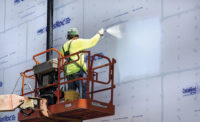If you’re in cold weather conditions and a client project just can’t wait, hope isn’t lost. Cold weather painting is possible with proper planning, spot-on preparation, and the right coatings. Here are some things to consider when painting in cold weather:
Schedule
Scheduling projects during optimal seasons not only saves time, but also minimizes potential frustration for both you and your client. For instance, initiating a major exterior restoration in January may result in delays due to weather conditions, potentially extending the timeline compared to starting in March. Being transparent and proactive by rescheduling when necessary as managing expectations is smart business.
Timing
Optimize your painting schedule by prioritizing prep work in the early morning and start painting around 10 a.m., finishing by 2 p.m. This ensures warmer surfaces for better paint adhesion, with sufficient drying time before temperature drops and dew forms. Remember, factors like humidity, wind speed, and direction also impact winter painting, influencing drying times and surface warmth retention.
Surface Temperature
Pay attention to the substrate temperature, as air and surface temperatures can vary widely. While air temperature may rise, it doesn’t mean that the substrate you’re about to paint is warm enough (ideally about 50 °F) to accept paint.
Coatings
Traditionally, most paints adhere to temperatures between 50 °F and 85 °F — but many manufacturers offer paints specifically formulated for cold environments. Most are rated for temperatures down to 35 °F, and are ideal in chilly regions. For example, BEHR MARQUEE® exterior paint, ULTRA® exterior paint, PREMIUM PLUS® exterior paint, and PRO® e600 exterior paint are formulated to perform in air, material, and surface temperatures as low as 35 °F.







